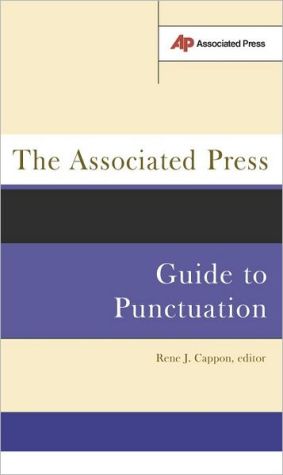The Associated Press Guide to Punctuation
More people write for the Associated Press than for any other news service, and more writers take their style and word-usage cues from this world-famous institution than from any other journalism source. In the no-nonsense, authoritative tradition of the best-selling AP Stylebook, the top editors at the AP have now written the definitive guide to punctuation. From the when and how of the ampersand to the rules for dashes, slashes, and brackets; from the correct moment for the overused...
Search in google:
From the editors at the world-renowned Associated Press, a guide to the proper use of punctuation--from the apostrophe to the semicolon Claire Rosser - KLIATT This is clear and concise, and as an editor I'm aware of how shaky most people's punctuation is. I personally go a little crazy around hyphens and was glad to read in this book that it still is forbidden to use a hyphen after an adverb that ends with "ly": e.g., don't put a hyphen in "amazingly-realistic work." (If you start looking, you'll see that this rule is frequently broken in publications.) This guide is a pleasure to read I'm not joking. For instance, here is the beginning of the chapter on the semicolon. "The semicolon is a compromise. It drifts, somewhat nebulously, between the period and the comma. To be pedantic, the semicolon means a shorter pause than the period and a longer pause than the comma." I like that clarity! The chapter continues, "Long or short pause, good stylists try to avoid it as too formal; decked out, as it were, in a starched shirt and a black suit. You would do well to keep semicolons at a minimum. There usually are options." This is a short book that should be helpful to many writers (every student) because the punctuation rules are so clearly cited and explained. KLIATT Codes: JSA Recommended for junior and senior high school students, advanced students, and adults. 2003, Perseus, 96p.,
1Introduction12The Ampersand73The Apostrophe94Brackets195Capitalization216The Colon277The Comma338The Dash519The Ellipsis5510The Exclamation Point5911The Hyphen6312Parentheses7113The Period7514The Question Mark7915Quotation Marks8316The Semicolon9117The Slash95
\ From Barnes & NobleMore people write for the Associated Press than any other news institution on earth. To guide these journalists through the thickets of commas, semi-colons, and ampersands, the AP has devised this concise, clearly worded guide. Reliable and easy to use.\ \ \ \ \ KLIATTThis is clear and concise, and as an editor I'm aware of how shaky most people's punctuation is. I personally go a little crazy around hyphens and was glad to read in this book that it still is forbidden to use a hyphen after an adverb that ends with "ly": e.g., don't put a hyphen in "amazingly-realistic work." (If you start looking, you'll see that this rule is frequently broken in publications.) This guide is a pleasure to read—I'm not joking. For instance, here is the beginning of the chapter on the semicolon. "The semicolon is a compromise. It drifts, somewhat nebulously, between the period and the comma. To be pedantic, the semicolon means a shorter pause than the period and a longer pause than the comma." I like that clarity! The chapter continues, "Long or short pause, good stylists try to avoid it as too formal; decked out, as it were, in a starched shirt and a black suit. You would do well to keep semicolons at a minimum. There usually are options." This is a short book that should be helpful to many writers (every student) because the punctuation rules are so clearly cited and explained. KLIATT Codes: JSA—Recommended for junior and senior high school students, advanced students, and adults. 2003, Perseus, 96p., \ — Claire Rosser\ \








